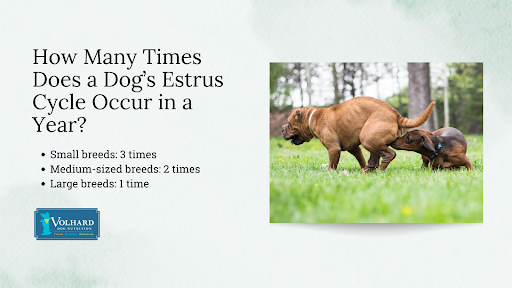Is False Pregnancy in Dogs Dangerous?
Posted by Volhard Dog Nutrition on Apr 27th 2023
False pregnancy — also known as pseudo-pregnancy or "phantom pregnancy" — describes a series of symptoms, both physical and behavioral, that occur after an estrus cycle in an unspayed female dog that is not actually pregnant. Simply put, your dog is getting ready to become a mother even though there are no puppies to bring to life!
False pregnancies are a pretty common condition among unspayed female dogs, with 80% of them showing signs at least once in the course of their life and 67% with recurring symptoms. A pseudo-pregnancy can occur as early as six months of age, when females reach puberty and experience their first heat cycle.
Is False Pregnancy a Dangerous Condition?
Just to put your concerns to rest, the answer is no — false pregnancies are not life-endangering conditions. In fact, they're considered fairly normal for an intact female dog.
One theory explaining phantom pregnancies takes us back to our dogs' wild ancestors. At that time, all the female dogs participated in nurturing the pack's puppies by providing protection and even producing milk. Researchers believe false pregnancies helped maternal instincts come to life, allowing all females to strengthen the pack.

When Do Phantom Pregnancies Start?
The physical signs of false pregnancy occur 45 to 60 days after the dog's last estrus cycle (i.e., the stage when a female dog can get pregnant, also known as a "heat cycle"). From then on, the symptoms can last anywhere from a week to a month. False pregnancies can begin at any age as long as your dog is going through her estrus cycle.
However, it is not guaranteed that your dog will deal with phantom pregnancies after every estrus cycle — just because it happens once doesn't mean it'll turn into a pattern.
Causes of Phantom Pregnancy in Dogs
False pregnancies are caused by the normal hormonal changes occurring every estrus cycle to prepare your dog's body for pregnancy. The heat cycle coincides with an increase in progesterone and other hormones necessary to host the fetuses. Once the female dog is no longer in heat, the decreasing progesterone levels are replaced by an increase in prolactin (i.e., the hormone necessary for preparing and maintaining lactation). The high prolactin hormone levels cause many of the phantom pregnancy symptoms.
False pregnancies can also be caused by spaying the dog too soon after an estrus cycle. The removal of the ovaries changes the hormone levels at a problematic time in the female dog's cycle, leading to signs of false pregnancy. If you're planning to spay your dog, wait at least 8 to 10 weeks after your dog's last estrus cycle.
Signs of False Pregnancy in Dogs
The phantom pregnancy symptoms are similar to both the physical and behavioral changes occurring during an actual pregnancy:
Physical Changes
- Fluid retention
- Lethargy
- Loss of appetite
- Milk production
- Periodic vomiting
- Signs of false labor
- Swollen mammary glands
Behavioral Changes
- Aggressive behavior
- Depression
- Nesting (65% of dogs with false pregnancies gather all their toys in one area, showing signs of overprotectiveness)

Ruling Out Any Potential Health Issues
Although false pregnancies are not life-endangering conditions, their symptoms are associated with health issues that might put your dog's well-being at risk, such as liver dysfunction or hypothyroidism. Be sure to contact your vet if the symptoms last longer than eight weeks to rule out any condition that could affect your dog's hormone levels.
Likewise, the vet will test your dog's blood for a hormone called relaxin — an accurate indicator of a true pregnancy.
How to Treat Phantom Pregnancies in Dogs
Most phantom pregnancies resolve themselves within a month, without any medical treatment — all your dog needs during this time is some tender loving care to overcome the symptoms.
Spaying your female dog is the most effective long-term strategy against a false pregnancy. Surgically removing the uterus, ovaries, and fallopian tubes stops the dog's estrus cycles, preventing false pregnancies from happening. Moreover, spaying female dogs helps prevent severe conditions like mammary gland cancer and deadly uterine infections.
In the meantime, you can soothe your dog's phantom pregnancy symptoms by:
- Avoiding any contact with the swollen mammary glands
- Preventing her from self-nursing by using a cone, a T-shirt, or an inflatable collar.
- Removing the toys she's been overprotective of
- Feeding a diuretic to minimize fluid retention or CBD for anxiety

Spaying is the Best Way to Prevent Future Episodes of False Pregnancy!
Although not life-threatening in and of themselves, false pregnancies are uncomfortable enough to affect your dog's well-being and peace of mind. Fortunately, the comfort of never having to worry about phantom pregnancies again is one spaying procedure away. So be sure to read our next month's blog to learn how to perfectly time your dog's spaying procedure! Also, for more advice on dog nutrition, health, and training, make sure that you contact us and check out our blog!
Volhard Dog Nutrition and its expert nutritionists are now offering online consultations to help more dog parents discover why, what, and how to feed their dogs the healthiest of foods! Speaking to a Volhard nutritionist will help you understand the inseparable relationship between healthy food, a healthy body, and a healthy mind. If you're interested in contacting one of our Volhard nutritionists, don't hesitate to access our
consultation page!

